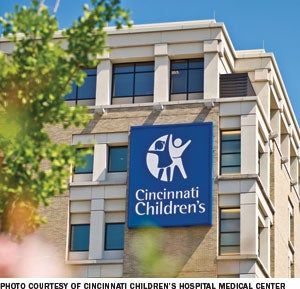Daily briefing puts safety first for staff, patients

Cincinnati Children's Hospital Medical Center's goal and ongoing challenge is to operate the safest health care facilities possible for patients and staff.
To maintain that focus, the health care system conducts mandatory operations briefings for heads of clinical and nonclinical departments every morning, including weekends. The calls inform all departments about any current or potential operational issues that could impact patient or staff safety, says Tom Kinman, vice president of facilities management at the medical center. The system includes three hospitals with a total of more than 500 patient beds and 15 outpatient locations, many of which operate around the clock.
The briefings, which started in November 2010 and generally last about 25 minutes, provide an opportunity for department heads to call in remotely and share important information about situations that may impact safety within the health care system. The calls, moderated by a safety officer or the administrator on call, are intended to prevent injuries from occurring or recurring.
For example, when facilities staff conduct electrical work or test generators, other departments are informed about the work through the briefing, says Jim Burger, assistant vice president of facilities management at Cincinnati Children's.
"The imaging department would actually shut down the MRIs because of some of the work we were doing," Burger says. "This allows the imaging and radiology departments to perform controlled and orderly shutdowns and reliable startups. This eliminates potential delays in patient care, which helps improve the overall patient experience."
Kinman relates a case in which a patient slipped off an exam table because the padding came loose, an incident that was discussed at a daily briefing. Exam tables were checked throughout the system and loose paddings were repaired in about a dozen other tables, which prevented problems.
While it's difficult to measure the impact of daily briefings because the hospital emphasizes safety through other ongoing initiatives, they likely are a factor in the downward trend of preventable injuries per 10,000 adjusted patient days and the Occupational Safety & Health Administration rate of recordable injuries, he says.
Kinman is a big fan of the program, which earned the American Society for Healthcare Engineering (ASHE) 2012 Excellence in Facilities Management Award. Kinman and Burger gave a presentation on it at ASHE's recent annual conference in Atlanta.
"I think from my standpoint — and I've been with the medical center about 30 years — the daily briefing is probably the single thing we have done to basically keep everybody connected as to what is important and what we need to do to mitigate certain situations when we run into them," Kinman says.
Steve Muething, M.D., vice president of patient safety at Cincinnati Children's, modeled the daily briefings after aircraft carrier flight operations, Kinman notes.
Safety data at the hospital can be viewed at www.cincinnatichildrens.org/about/quality-measures/default.




